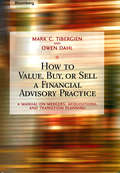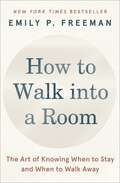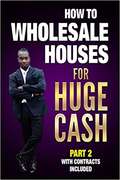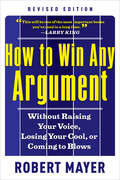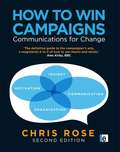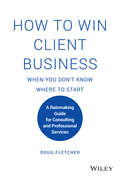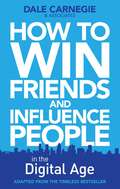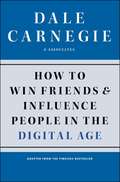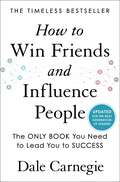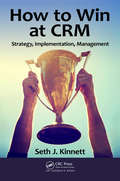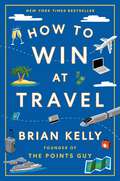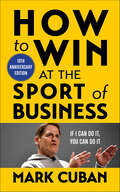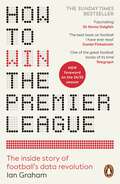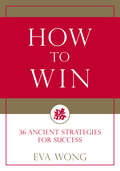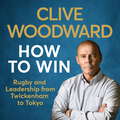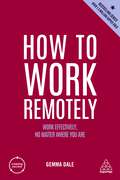- Table View
- List View
How to Value, Buy, or Sell a Financial Advisory Practice: A Manual on Mergers, Acquisitions, and Transition Planning (Bloomberg Financial #58)
by Mark C. Tibergien Owen DahlFinancial planning is a young industry. The International Association of Financial Planning—one of the predecessors to the Financial Planning Association—was formed less than forty years ago. But as the profession's first tier of advisers reaches maturity, the decisions that may be part of transition planning for their firms loom large. A sale? A partner buyout? A merger? No matter what the choice, its viability hinges on one critical issue—the value of the firm. Unfortunately, many advisers--whether veteran or novice—simply don't know the worth of their practice or how to influence it. That's why How to Value, Buy, or Sell a Financial-Advisory Practice is such an important book. It takes advisers carefully through the logic and the legwork of coming to a true assessment of one of their most important personal assets—their business. Renowned for their years of experience helping advisers tackle the daunting challenges related to the valuation, sale, and purchase of advisory firms, Mark C. Tibergien and Owen Dahl offer guidance that's essential and solutions that work.
How to Walk into a Room: The Art of Knowing When to Stay and When to Walk Away
by Emily P. FreemanIf life were a house, then every room holds a story. What do we do when a room we’re in is no longer a room where we belong?What do you do when you start to feel a shift and must decide if it’s time to make a change? When it comes to navigating big decisions about when to stay and go, how can we know for sure when the time is right? Though we enter and exit many rooms over the course of our life—jobs, relationships, communities, life stages—knowing how and when it’s time to leave is a decision that rarely has a clear answer.Podcast host, spiritual director, and bestselling author of The Next Right Thing, Emily P. Freeman offers guidance to help us recognize when it’s time to move on from situations that no longer fit, allowing us to find new spaces where we can flourish and grow.How to Walk Into a Room helps us begin to uncover the silent, nuanced, and hidden arrows for anyone asking questions like: How do I know if it’s time to move on? What if I stay and nothing changes? What if I leave and everything falls apart?Through thought-provoking questions, spiritual practices, and personal stories, How to Walk into a Room will help you to know and name the caution flags in your current spaces, discern the difference between true peace and discomfort avoidance, navigate endings even when there is no closure, find peace for when you feel ready but it isn’t time, and courage for when it’s time but you don’t feel ready. For anyone standing in a threshold, here’s a book to help discern the how, when, and what now of walking out of rooms and into new ones with peace, confidence, and a whole heart.
How to Wholesale Houses for Huge Cash Part 2: With Contracts Included
by Ernie Braveboy<p>This book is a step by step guide to closing your first real estate without needing any of your own money or credit. In this book i give you all the tools to close your first real estate deal . would you like to make $5000 per deal without using your cash or credit. This book aims to guide you through the process of becoming financially free through real estate investing. <p>This was written for people who are fed up with the traditional "rat race" style of living and want to create a new way of living no matter if you have never been involved in real estate or have any money of your own. This book will guide your mind and actions to building massive wealth step by step. If you want to make thousands of dollars per month you need this book. Anyone can build financial freedom by changing his or her mindsets and improving his or her daily habits. This book will change the way that you think about money and the way you think about the opportunity surrounding you each and every day. This book will inspire you to begin your own real estate business and provide a living for your family that you only dreamed of get started today and make money like top 1% wholesaling houses without using your cash or credit.</p>
How to Win
by Clive WoodwardIn his entertaining and informative new book, Sir Clive Woodward analyses the events of the 2019 Rugby World Cup, offering his unique perspective on the performance of players and coaches, from Owen Farrell and Kieran Read, to Eddie Jones and Steve Hansen.HOW TO WIN:Rugby and Leadership from Twickenham to Tokyo is much more than the story of a tournament, however. It is the distillation of a philosophy of leadership developed during a lifetime in high-performance environments, from the rugby field to the boardroom. Tapping into his experience of winning the 2003 World Cup, being a part of the leadership team that delivered Olympic Success in 2012 and lessons drawn from Japan 2019, the author delivers a go-to manual in how to improve both individual and team performance in order to reach the pinnacle in sport and in business.Every individual position in rugby requires a unique set of skills, knowledge and expertise that collectively form a balanced team; the same is true in any successful business or organisation. From 1 to 15, the former England and British and Irish Lions coach identifies the key attributes and uses these defining traits to explain his collaborative 'Teamship' leadership style.With a fascinating blend of analysis, insight and anecdote, and the highs and lows of a memorable Rugby World Cup as the setting, Clive reveals how to lead the culture of a winning team - in any context.
How to Win
by Rob YeungNever come second place againSay goodbye to feelings of inadequacy - never again will you have to look on while someone else gets that promotion you wanted, wins the pitch you went for or beats you on the playing field. Bid farewell to that sense of jealously when someone else comes out on top, or that frustration when someone argues your socks off and leaves you defeated. Now you can be the winner.Psychologist and bestselling author Dr Rob Yeung will show you how to triumph when it really counts. How to gain the competitive advantage and come first more often. How to win arguments, negotiations, pitches, job interviews and more. Based on the latest research and proven psychological principles, Rob explains the science behind winning and how you can apply them to all facets of your life.If you're not winning, you're losing. Don't be a loser. Learn to win."If you want to be the best you can be, How to Win will help you to make the most out of the opportunities you have." Dame Sarah Storey, 11-times Paralympic Gold medallist"Fun to read, strong on evidence and full of useful techniques - an ideal book for those wanting to get into 1st place." Dr. Sebastian Bailey, co-founder and President, Mind Gym "Rob's advice is practical, to the point and above all effective. Another must-read - and must-do!" Julian Ranger, Founder & Chairman, SocialSafe"This book is a winner in every respect. Evidence-based advice in a well-constructed, highly-readable and easily recalled format. What's stopping you being a winner? Perhaps it's the fact you've yet to read Rob Yeung's excellent book." Robert Kelsey, author of What's Stopping You? and What's Stopping You Being More Confident?"How to Win provides practical information to people on getting ahead in their career, the soft skills necessary to be successful at work, from networking to being more assertive to using political skills. This is a must read for anyone wanting to succeed in their jobs and careers." Professor Cary L. Cooper, CBE, Distinguished Professor of Organizational Psychology and Health at Lancaster University Management School"Inspirational but with practical tips - a must read whether you're starting out or an experienced professional." Carol-Ann White, Global Human Resources Director, branding consultancy FITCH"How to Win is a great blend of compassion and practical experience. Dr Rob Yeung provides simple and logical steps to making a difference and wraps each one in stories and examples that speak to everyone. This book will make you rethink your approach to every situation and applying the ideas will change your life and performance at work in a very positive way. Highly recommended." Gary White, Chief Executive, sales technology company White Springs
How to Win Any Argument
by Robert MayerThis guide to negotiating is “mental judo, where you use the other guy’s energy to win. It’s mind-set. It’s charisma” (New York Times).The art of the argument. It’s mysterious and powerful. It’s the art of having things go your way. But it’s also the art of getting out of your own way. It’s having the Moves. But it’s also about having the Touch. Welcome to the “new normal.” It’s a time and place where conversations are tougher, disagreements more frequent, consensus more difficult to find than ever before. This new world demands three new “right for our times” chapters:“Heavy Metal Moves” and “Taboo Tactics”: When you’re being dissed, dismissed, and dumped on. Or when you need to break through.“Waging Peace: The Mediation, Arbitration, and Collaborative Practice Game”: Because there’s more conflict but less money to hire litigation lawyers.“The World Has Gotten Smaller”: Learn to identify deep-rooted cultural differences, and how to act and react.“This will be one of the most important books you’ve read in a long time.” —Larry King“Two thumbs up! A whole new way of being smart about all the people in your life—coworkers, bosses, family, the people you do business with. Bob Mayer tells you how to finesse the results you want without pleading, prodding, pushing, or pulling.” —Cuba Gooding, Jr., Academy Award–winning actor
How to Win Campaigns: Communications for Change
by Chris RoseHow to Win Campaigns is a practical guide for creating and running successful campaigns. Written for the new campaigner and the experienced communicator alike, it explores what works (and what doesn't) and shows how to use principles and strategy in campaigning as a new form of public politics. Applicable to any issue and from any point of view, the book's key steps and tools provide models of motivation, analysis and communication structure. This fully revised and updated second edition includes the following new features: * Campaign Master Planner * Political Checklist * Motivational Values * Behaviour Change * Campaigning and the Climate Issue * Dealing With Disasters * Using Celebrities * Being Interesting * Brainstorming * Visual Narratives * A Strategy For Values, Behaviour, Politics and Opinion * Emergencies * Tame and Wicked Problems * How To Tell If You Are Winning * Plus all new case studies on - new media and the Obama campaign, the smoking ban, chemicals and health and greening Apple computers.
How to Win Client Business When You Don't Know Where to Start: A Rainmaking Guide for Consulting and Professional Services
by Doug FletcherDramatically grow your client base following pragmatic and insightful advice by bestselling author Doug Fletcher How to Win Client Business When You Don't Know Where to Start: A Rainmaking Guide for Consulting and Professional Services serves as an invaluable and indispensable guide for everyone in the business of selling professional and consulting services. Author Doug Fletcher dives deeply into the five skills required to "make it rain": Create Your Personal Brand Identity Demonstrate Your Professional Expertise Build Your Professional Ecosystem Develop Trust-Based Relationships Practice Everyday Success Habits How to Win Client Business When You Don't Know Where to Start provides a masterclass in teaching the practical techniques and concrete strategies that professional services providers were never taught in school or on the job. Pragmatic lessons take the place of the vaguely defined principles found in competing books to turn readers from sales novices into rainmakers. Written by the same celebrated author who brought readers the best-selling book How Clients Buy, How to Win Client Business When You Don't Know Where to Start is perfect for any professional services provider or consultant who seeks to dramatically increase their book of business.
How to Win Friends and Influence People in the Digital Age
by Dale Carnegie Inc. AssociatesSince its initial publication, How to Win Friends and Influence People has sold a total of 15 million copies. The book continues to sell briskly today, but Carnegie never anticipated the ways in which the digital age would provide new tools and challenges for winning friends and influencing people. The advent of social networking sites, the dominance of email, and the ways in which the Internet has supplanted face-to-face interactions have made Carnegie's precepts all the more immediate and vital. Brent Cole, working in tandem with Dale Carnegie & Associates, Inc., has reimagined the original book for the digital age, updating and reframing Carnegie's insights about communication, self-expression, and leadership.
How to Win Friends and Influence People in the Digital Age (Dale Carnegie Books)
by Dale Carnegie AssociatesAN UP-TO-THE -MINUTE ADAPTATI ON OF DALE CARNEGIE 'S TI MELE SS PRESCRIPTI ONS FOR THE DIGITAL AGE DALE CARNEGIE's commonsense approach to communicating has endured for a century, touching millions and millions of readers. The only diploma that hangs in Warren Buffett's office is his certificate from Dale Carnegie Training. Lee Iacocca credits Carnegie for giving him the courage to speak in public. Dilbert creator Scott Adams called Carnegie's teachings "life-changing." In today's world, where more and more of our communication takes place across wires and screens, Carnegie's lessons have not only lasted but become all the more critical. Though he never could have predicted technology's trajectory, Carnegie proves a wise and helpful teacher in this digital landscape. To demonstrate the many ways his lessons remain relevant, Dale Carnegie & Associates, Inc., has reimagined his prescriptions and his advice for this difficult digital age. We may communicate today with different tools and with greater speed, but Carnegie's advice on how to communicate, lead, and work efficiently remains priceless across the ages.
How to Win Friends and Influence People: Updated For the Next Generation of Leaders (Deluxe Hardbound Edition Ser.)
by Dale CarnegieUpdated for the first time in more than forty years, Dale Carnegie&’s timeless bestseller How to Win Friends and Influence People—a classic that has improved and transformed the personal and professional lives of millions.This new edition of the most influential self-help book of the last century has been updated under the care of Dale&’s daughter, Donna, introducing changes that keep the book fresh for today&’s readers, with priceless material restored from the original 1936 text. One of the best-known motivational guides in history, Dale Carnegie&’s groundbreaking publication has sold tens of millions of copies, been translated into almost every known written language, and has helped countless people succeed. Carnegie&’s rock-solid, experience-tested advice has remained relevant for generations because he addresses timeless questions about the art of getting along with people. How to Win Friends and Influence People teaches you: -How to communicate effectively -How to make people like you -How to increase your ability to get things done -How to get others to see your side -How to become a more effective leader -How to successfully navigate almost any social situation -And so much more! How to Win Friends and Influence People is a historic bestseller for one simple reason: Its crucial life lessons, conveyed through engaging storytelling, have shown readers how to become who they wish to be. With the newly updated version of this classic, that&’s as true now as ever.
How to Win Grants: 101 Winning Strategies
by Alan SilverConcisely written and easy to follow, How to Win Grants demonstrates a three-stage grant development model distilled into 101 actionable strategies, arranged in order of execution and supplemented by helpful checklists. In stage one, "Prepare," grantseekers begin by assessing their personal and agency fundability, improving their positioning for grants, learning shortcuts to planning successful grant projects, and finding out how to locate the most likely sources of grant funding. In stage two, "Persuade," grantseekers learn how to convince private and public grantmakers that their project deserves funding by adapting their project plan to the specific needs of each funder. In stage three, "Perform," readers learn the most important ways to continue attracting grant funding for the long term. This indispensable guide also dispels widespread myths about grantseeking, identifies unproductive behaviors to avoid, and teaches readers how to engage the funder's interest and make the most compelling case for their project. With all this and more, How to Win Grants is every individual and organization's ticket to a winning grantseeking campaign!
How to Win Your Personal Injury Claim
by Joseph MatthewsAfter your injury: Settle your claim the right way When you've been hurt in an accident, dealing with insurance companies and lawyers can feel exhausting. But armed with the right information, you can handle a claim yourself--and save many thousands of dollars in the process. How to Win Your Personal Injury Claim shows you how to handle almost any accident situation and guides you through the insurance claim process, step by step. Learn how to: protect your rights after an accident determine what your claim is worth deal with uncooperative doctors and insurance companies counter the special tactics insurance companies use prepare a claim for compensation negotiate a full and fair settlement stay on top of your case if you hire a lawyer This completely updated edition of How to Win Your Personal Injury Claim provides your state's most recent laws, including small claims court limits and lawsuit filing deadlines. a new chart explaining your state's in-car text and cell phone laws.
How to Win Your Personal Injury Claim
by Joseph MatthewsAfter your injury: Settle your claim the right way When you’ve been hurt in an accident, dealing with insurance companies and lawyers can feel exhausting. But armed with the right information, you can handle a claim yourself—and save many thousands of dollars in the process. How to Win Your Personal Injury Claim shows you how to handle almost any accident situation and guides you through the insurance claim process, step by step. Learn how to: protect your rights after an accident determine what your claim is worth deal with uncooperative doctors and insurance companies counter the special tactics insurance companies use prepare a claim for compensation negotiate a full and fair settlement stay on top of your case if you hire a lawyer This completely updated edition of How to Win Your Personal Injury Claim provides the latest state laws on small claims limits, no-fault car insurance, distracted driving, and lawsuit-filing deadlines.
How to Win Your Personal Injury Claim (6th edition)
The attorney author provides tips on both claims that consumers can handle themselves and those requiring working with a lawyer. Matthews discusses how fault is legally determined and covers all phases of the claim process. Helpful features include insurance contact information by state, sample documentation, and an accident claim worksheet. Annotation ©2004 Book News, Inc., Portland, OR (booknews.com)
How to Win at CRM: Strategy, Implementation, Management
by Seth KinnettThis book provides clarity and guidance on effective strategy, implementation and management of CRM. It explores both the conceptual and cultural context of CRM initiatives along with the particulars of CRM system implementation and management. In order to provide this clarity, it surveyed the existing academic publications surrounding CRM, sales force automation, and related topics within information systems literature. The book supplements this research with insights from CRM experts to provide a robust picture of the CRM landscape and how to improve it no matter what role you play within your organization. This book is for everyone who wants to achieve CRM success.
How to Win at Shopping: 297 Insider Secrets for Getting the Style You Want at the Price You Want to Pay
by Eila Mell David ZylaA book worth its weight in gold—or what one charges on a gold card. Written by two fashion experts with deep experience in fashion shopping and styling, How to Win at Shopping is perfect for the woman who loves to shop—there is priceless information on every page. And perfect for the woman who hates to shop—here’s the game plan to make it work. And for both, hundreds of ways to save money, time, and aggravation. Page after page is filled with knowledgeable insider tips, the hows and whys of shopping smart: Always beware of prices in carpeted areas of a store. Three-quarter sleeves are always flattering. Sometimes, for certain items like T-shirts or knits, it makes sense to shop in the boys’ department. For shoes, the best toe shape will always match your best neckline. Never shop in a hurry. When approaching a rack of clothing, always start with color. Always sit down when trying on clothing. There are style basics, like how to find the perfect pair of jeans. Money-saving tips, like why never to open a store credit card. Shopping rules, like leave your jewelry at home when shopping. Plus tips for shopping online, in thrift stores, and around the holidays. And throughout, separate lists, like the 15 secrets of finding clothes that make you look ten pounds thinner; the seven things a tailor can do—and six things a tailor can’t; and the top ten wardrobe staples.
How to Win at Travel
by Brian KellyTurn your wanderlust into reality with expert strategies from Brian Kelly, the founder of The Points Guy—the leading voice in travel and loyalty programs—with this ultimate resource for everything from leveraging airline and credit card points to planning your dream itinerary.In How to Win at Travel, Brian Kelly shares his greatest tips and strategies to experience the world in ways you never thought possible. This comprehensive guide is a road map with all of the knowledge and tools you need to become an expert traveler. Get practical advice on a range of topics, including how to find the cheapest flights; effectively leverage airline, hotel, and credit card loyalty programs; conquer your fear of flying; beat jet lag; and score free flights and upgrades. Kelly also covers the ins and outs of travel insurance and getting the right credit cards to make your travel more affordable and enjoyable. He discusses the art of dealing with travel mishaps, speaks to the technology you need to manage modern travel, and shares ideas for pinpointing the best destination for you. Whether you&’re a young adult traveling solo, a road warrior business traveler, a growing family looking for new experiences, or a retiree ready to explore the world, reach for this guide to plan an unforgettable trip. Easy to read, informative, and inspirational, How to Win at Travel is the definitive travel guide for your next adventure, no matter how big or small.
How to Win at the Sport of Business
by Mark CubanThe Shark Tank celebrity reveals how he became one of the world’s wealthiest and most influential businessmen.“Cuban [explains] what it means to have ‘the edge,’ the necessary drive to forego the confines of a comfortable job, triumph over setbacks, and build a successful company.” —Business Insider“Exceeded . . . expectations.” —Huffington PostIn How to Win at the Sport of Business, Mark Cuban collects his greatest lessons on what it takes to become a thriving entrepreneur. Drawing upon his profound insider knowledge, Cuban offers unconventional business tips and tells his stunning rags-to-riches tale from selling powdered milk and sleeping on friends’ couches to owning his own company and becoming a multi-billion-dollar success story. Mark shows how he puts his own advice into practice and how entrepreneurs at any stage of their careers can outmaneuver their competitors.
How to Win in a Winner-Take-All World: The Definitive Guide to Adapting and Succeeding in High-Performance Careers
by Neil IrwinFrom New York Times bestselling author and senior economic correspondent at The New York Times, how to survive—and thrive—in this increasingly challenging economy.Every ambitious professional is trying to navigate a perilous global economy to do work that is lucrative and satisfying, but some find success while others struggle to get by. In an era of remarkable economic change, how should you navigate your career to increase your chances of landing not only on your feet, but ahead of those around you? In How to Win in a Winner-Take-All World, Neil Irwin, senior economic correspondent at the New York Times, delivers the essential guide to being successful in today’s economy when the very notion of the “job” is shifting and the corporate landscape has become dominated by global firms. He shows that the route to success lies in cultivating the ability to bring multiple specialties together—to become a “glue person” who can ensure people with radically different technical skills work together effectively—and how a winding career path makes you better prepared for today's fast-changing world. Through original data, close analysis, and case studies, Irwin deftly explains the 21st century economic landscape and its implications for ambitious people seeking a lifetime of professional success. Using insights from global giants like Microsoft, Walmart, and Goldman Sachs, and from smaller lesser known organizations like those that make cutting-edge digital effects in Planet of the Apes movies or Jim Beam bourbon, How to Win in a Winner-Take-All World illuminates what it really takes to be on top in this world of technological complexity and global competition.
How to Win the Premier League: The Sunday Times Bestselling Inside Story of Football's Data Revolution
by Ian GrahamTHE SUNDAY TIMES BESTSELLER AND A FINANCIAL TIMES, SUNDAY TIMES AND TELEGRAPH BOOK OF THE YEAR 2024'The best book on football I have ever read' Daniel Finkelstein'Fascinating and educational. An enjoyable and informative read' Sir Kenny Dalglish'Deserves a place among the great modern books on football' Sam Wallace, chief football writer, Telegraph______________________________The insider account of the data revolution that has swept through the modern football world written by one of its key architects, Ian Graham.Between 2012 and 2023, Ian Graham worked as Liverpool FC's Director of Research. His tenure coincided with the club’s greatest period of success since the 1980s, including winning the Premier League in 2020 – Liverpool’s first league title after an agonising three decades.Here for the first time, Graham reveals the fascinating data that informed some of the club’s most pivotal moments of the past decade, from the appointment of Jurgen Klopp as manager in 2015 to the signing of Mohamed Salah in 2017. Along the way, he shares groundbreaking insight into the modern game, including how a season largely played behind closed doors transformed our understanding of home team advantage, or why the GOAT (greatest of all time) might not be who you think. And, in a game that is increasingly dominated by an elite few, Graham charts a path for the future where a data-savvy competitor will always find the edge.______________________________'A fascinating, witty and remarkably insightful account of Liverpool's reinvention and a clear-eyed, detailed explanation of the inner workings of modern football. Nobody is better qualified to tell either of those stories than Ian Graham, who stands as one of the most (quietly) significant figures in the recent history of the club and the sport' Rory Smith, author of Expected Goals and Chief Soccer Correspondent, New York Times'Never before has the data revolution in football been described so well from the inside.' Christoph Biermann, author of Football Hackers‘How to Win the Premier League gives you three books for the price of one: a book about all of the silly inefficiencies plaguing European football, a book about what it's like to be empowered to use outside-the-box thinking to help turn your boyhood club into the best team in the world, and a book about how football actually works. If he really wanted to, Ian could easily put me out of a job.’Ryan O’Hanlon, author of Net Gains and staff writer ESPN*A Sunday Times bestseller August 2024
How to Win: 36 Ancient Strategies for Success
by Eva WongPotent advice on how to think and act strategically in business, politics, and relationships--drawn from classic Chinese military and political expertise.The ancient strategies of war and politics have much to offer us in navigating the complicated challenges we face today--and to help us wisely and effectively meet our business, political, and relational goals. Here, eminent Chinese scholar and Taoist teacher Eva Wong unpacks the wisdom of The Thirty-Six Strategies, a collection of advice encoded in sayings, steeped in Chinese history and culture. She explores strategies attributed to renowned military philosophers such as Sun Tzu and Zhuge Liang (aka "The Sleeping Dragon"), along with other less-known advisors, that were implemented during three of the most chaotic eras of Chinese history--the Spring and Autumn Period, the Warring States Period, and the Three Kingdoms. Covering three categories of strategy--proactive, reactive, and desperate--Wong expertly connects the words of ancient military philosophers with timeless advice, as useful today as it was in the Tang dynasty (618-906) when this collection was originally gathered. In Chinese military philosophy and political theory, the thirty-six strategies are considered "yin" or "shadow" in nature, meaning that they operate best in darkness and concealment. As Wong writes, "Desperate times call for desperate measures, and since the thirty-six strategies rose out of times of war and conflict, it is inevitable that they were used to win wars, triumph over opponents, take advantage of situations, and survive when defeat is imminent."
How to Win: Rugby And Leadership From Twickenham To Tokyo
by Clive WoodwardIn his entertaining and informative new book, Sir Clive Woodward analyses the events of the 2019 Rugby World Cup, offering his unique perspective on the performance of players and coaches, from Owen Farrell and Kieran Read, to Eddie Jones and Steve Hansen.HOW TO WIN:Rugby and Leadership from Twickenham to Tokyo is much more than the story of a tournament, however. It is the distillation of a philosophy of leadership developed during a lifetime in high-performance environments, from the rugby field to the boardroom. Tapping into his experience of winning the 2003 World Cup, being a part of the leadership team that delivered Olympic Success in 2012 and lessons drawn from Japan 2019, the author delivers a go-to manual in how to improve both individual and team performance in order to reach the pinnacle in sport and in business.Every individual position in rugby requires a unique set of skills, knowledge and expertise that collectively form a balanced team; the same is true in any successful business or organisation. From 1 to 15, the former England and British and Irish Lions coach identifies the key attributes and uses these defining traits to explain his collaborative 'Teamship' leadership style.With a fascinating blend of analysis, insight and anecdote, and the highs and lows of a memorable Rugby World Cup as the setting, Clive reveals how to lead the culture of a winning team - in any context.
How to Win: Rugby and Leadership from Twickenham to Tokyo
by Clive WoodwardIn his entertaining and informative new book, Sir Clive Woodward analyses the events of the 2019 Rugby World Cup, offering his unique perspective on the performance of players and coaches, from Owen Farrell and Kieran Read, to Eddie Jones and Steve Hansen.HOW TO WIN: Talent Alone is Not Enough is much more than the story of a tournament, however. It is the distillation of a philosophy of leadership developed during a lifetime in high-performance environments, from the rugby field to the boardroom. Tapping into his experience of winning the 2003 World Cup, being a part of the leadership team that delivered Olympic Success in 2012 and lessons drawn from Japan 2019, the author delivers a go-to manual in how to improve both individual and team performance in order to reach the pinnacle in sport and in business.Every individual position in rugby requires a unique set of skills, knowledge and expertise that collectively form a balanced team; the same is true in any successful business or organisation. From 1 to 15, the former England and British and Irish Lions coach identifies the key attributes and uses these defining traits to explain his collaborative 'Teamship' leadership style.With a fascinating blend of analysis, insight and anecdote, and the highs and lows of a memorable Rugby World Cup as the setting, Clive reveals how to lead the culture of a winning team - in any context.(P) 2019 Hodder & Stoughton Ltd
How to Work Remotely: Work Effectively, No Matter Where You Are (Creating Success #13)
by Gemma DaleNon-office based work is here to stay, but everyone experiences it differently. Find out how to make working at home and remote work, work for you. How to Work Remotely will help anyone adapt to home, remote and hybrid working. Suitable for homeworkers, or the managers and leaders of homeworkers, this highly practical book will address how to be successful and build a career while working remotely, or away from the office. Packed with practical exercises and top tips, the book includes advice on wellbeing when working from home, how to get organized, how to start a new role when you're not in the office and suggestions on the best ways to be productive. HR specialist Gemma Dale also explains about managing the performance of remote and hybrid teams and effectively making home working accessible for all colleagues.The Creating Success series of books...Unlock vital skills, power up your performance and get ahead with the bestselling Creating Success series. Written by experts for new and aspiring managers and leaders, this million-selling collection of accessible and empowering guides will get you up to speed in no time. Packed with clever thinking, smart advice and the kind of winning techniques that really get results, you'll make fast progress, quickly reach your goals and create lasting success in your career.
